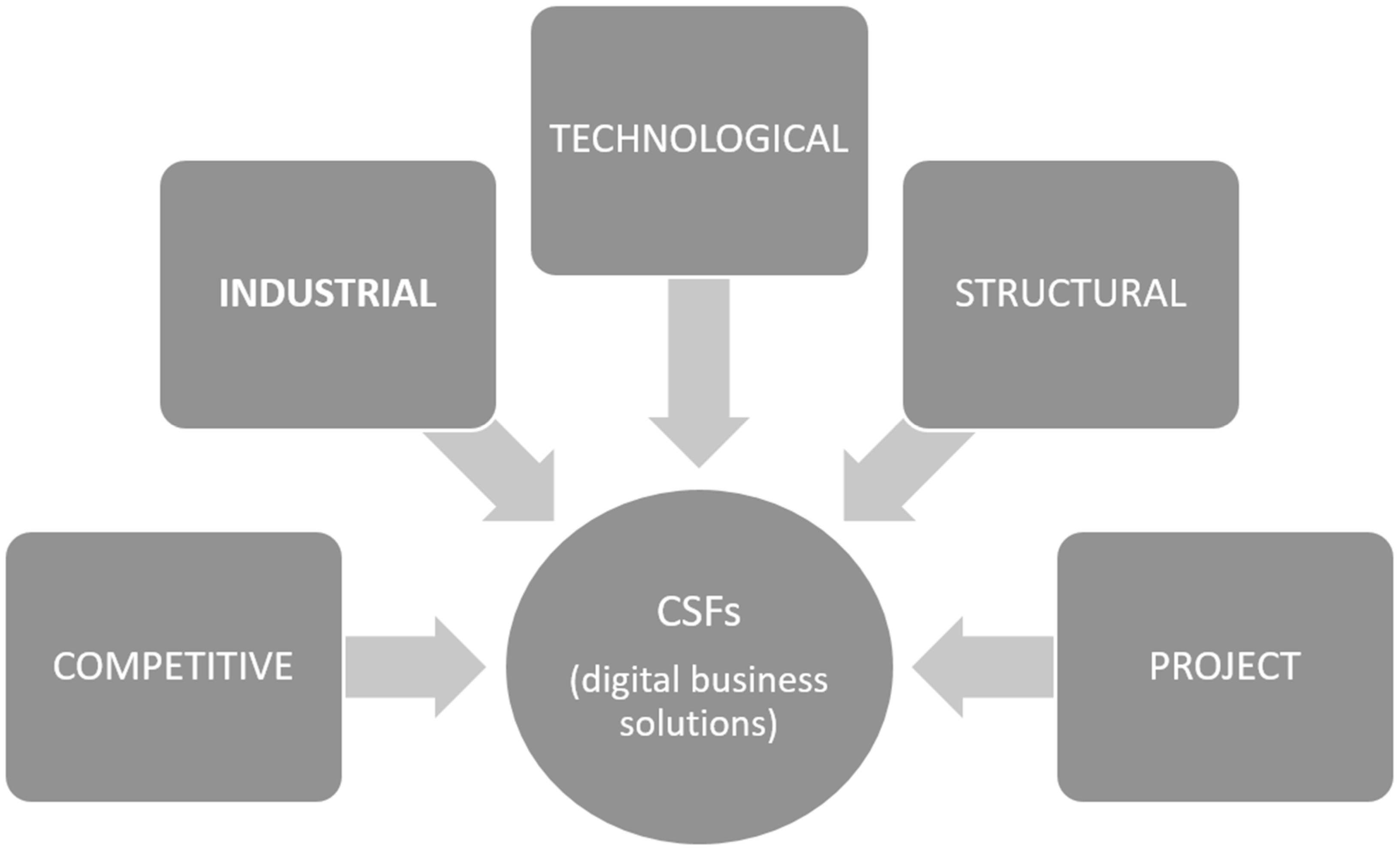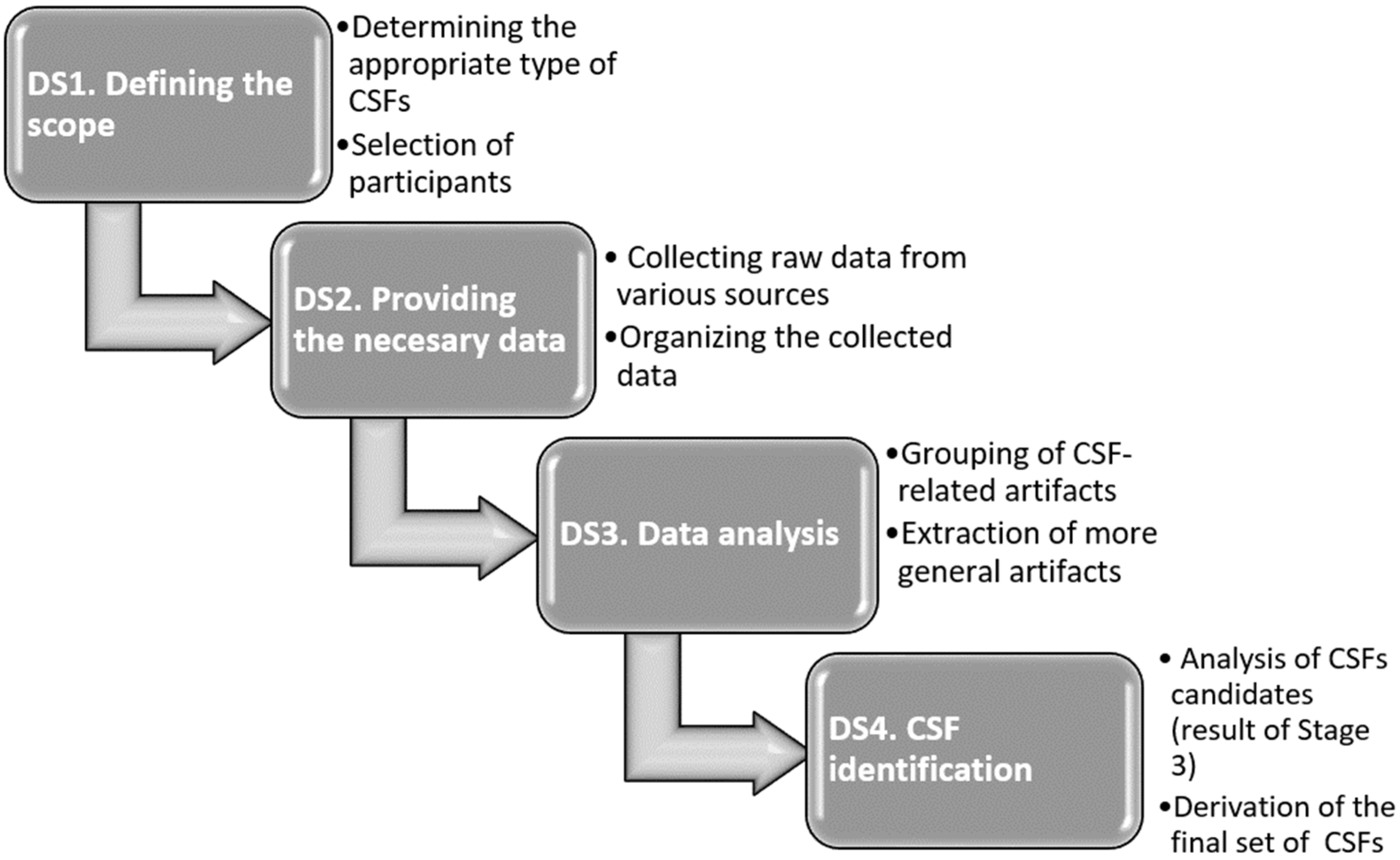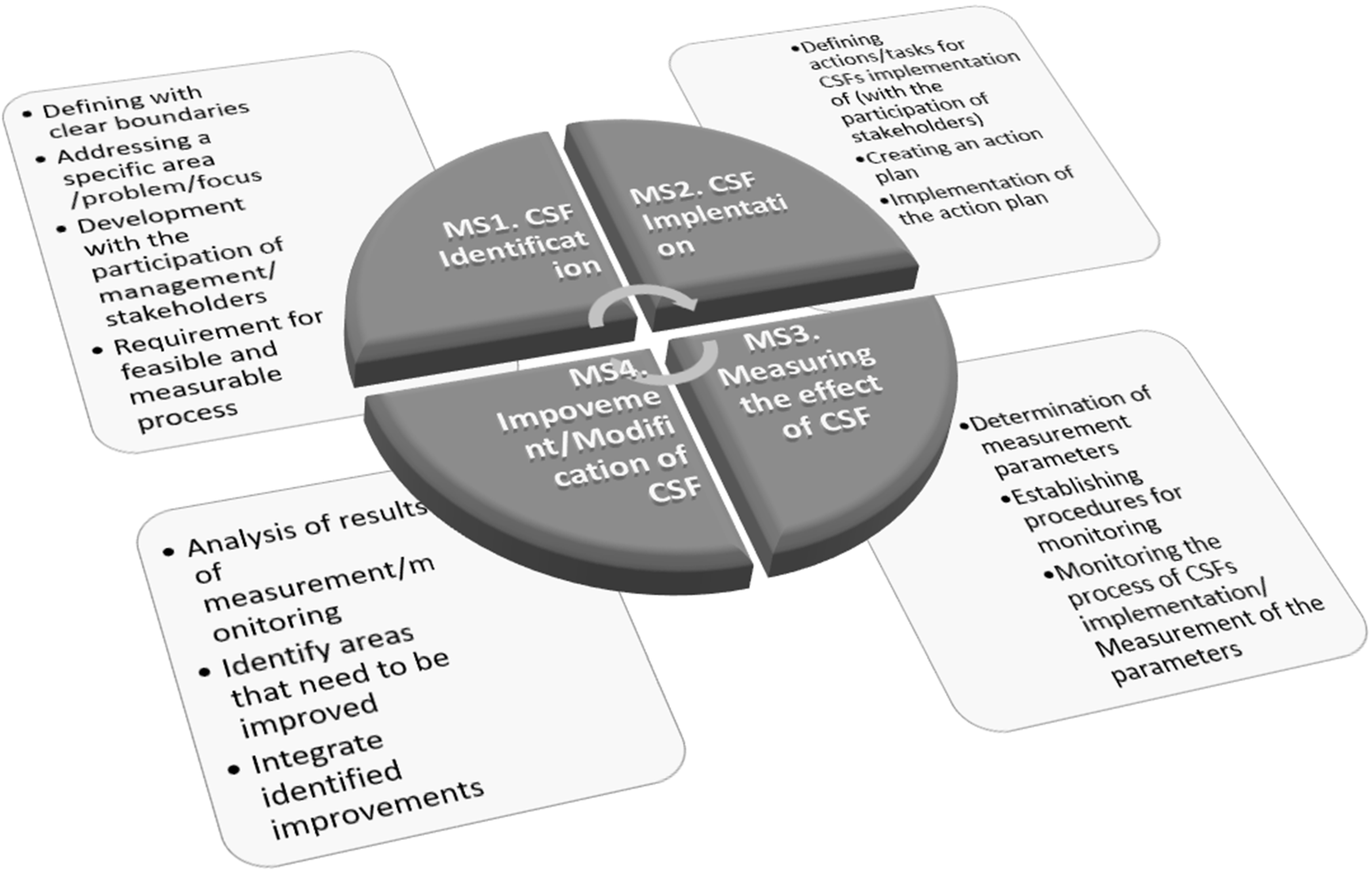Adoption of Digital Business Solutions: Designing and Monitoring Critical Success Factors
Abstract
1. Introduction
- to identify the individual information needs of top managers;
- for the needs of the strategic, long-term and annual planning process;
- when it is planned, to create an information system for the organization that meets the information needs of top managers.
2. Framework Part 1. CSFs Design
2.1. CSFs Sources
- The competitive strategy and competitive position of the business organization to partners (competitive/partner). CSFs depend on the organization’s rate in the industry compared to its competitors, its history and competitive strategies.
- The characteristics of the technological environment (technological)—in the classical theory related to CSFs, characteristics of the general environment (economic, political, social and technological) are taken into account here. However, the proposed framework mainly considers technological innovations in the digitalization field. These innovations should be important particularly in this case and have a significant impact on the adoption of projects for digital business solutions.
- The peculiarities of the management structure(structural)—this source determines the factors that depend on the internal organization’s management structure and the managers’ responsibilities at different levels (specific to the direction of the industry in which the organization operates).
- Requirements for the success of the project(project)—this source determines the internal factors (competencies and resources) that determine the success of the project and the related stages and activities.
2.2. Designing
2.2.1. DS1. Defining the Scope of CSFs
- Corporate CSFs are strongly related to and are somewhat derived from the collective CSFs of the operational units of the organization. However, in the absence of time to determine the CSFs of each organization unit, a set of corporate CSFs may be created to be representative of all operational units.
- If the organization structure is flat (i.e., there are not many layers of management), a set of corporate CSFs can actually be highly representative and be applied instead of any necessary set of collective CSFs.
- On the other hand, the organization can have many layers of management and many divisions, sometimes even involved in different industries. Even in such cases, it is required to create corporate CSFs, it will be best to develop collective CSFs for individual divisions, as essentially each is a separate, functioning organization.
2.2.2. DS2. Providing the Necessary Data
- the stated, documented mission and vision of the organization and/or the operational unit;
- the indicated goals and tasks for the current year (fiscal or calendar) for the participants in the CSFs activities;
- performance indicators, collected about all stated goals and tasks;
- the short-term plan of the organization/operational unit or the long-term strategic plan;
- internal audit reports or other relevant documents;
- annual reports and other similar documents;
- industry reports for the primary industry to which the activity of the organization relates;
- scientific or technical literature representing existing related CSF sets or related analyses;
- CSFs of partner or branch organizations from the same branch;
- opinions on the CSFs of the staff of the company/unit.
2.2.3. DS3. Data Analysis
- independence—not to indicate which of the staff provided them (to avoid bias or influence);
- condensation—to be shortened to the level of their essential meaning or idea (to remove ambiguity);
- shape—to be converted into controllable pieces or units that can be analyzed.
2.2.4. DS4. CSFs Identification
- be worded clearly, concisely and be easy to understand. Interpretations by different managers are not relied upon to understand the CSFs’ meaning;
- propose specific actions or activities performed by the organization/unit, typical for the operational work or the business domain;
- suggest improvements or recommendations which have to be made;
- begin with verbs describing actions or activities—attract, perform, expand, observe, manage, expand, etc.
- Planning:
- Starting with the end in mind;
- Identifying value drivers;
- Discovering your potential;
- Developing a plan for digital transformation;
- Deploying in the cloud, on-premise, or hybrid;
- Choosing greenfield or brownfield project investment;
- Partnering to move ahead;
- Design:
- Jump-starting the design process;
- Get a seat at the table;
- Controlling complexity;
- Development:
- Sprinting to the finish line;
- Taking a factory-like approach to configuration;
- Automating the testing process;
- Transitioning to operations.
3. Framework Part 2. CSFs Monitoring
3.1. MS1. CSFs Identification
- have clear boundaries and a specific area of application, focus or problem to solve;
- allow the implementation of strategies and action plans of management/relevant stakeholders that address the underlying area/problem/focus;
- require a workable process with a measurable result regarding accepted benchmarks or performance criteria.
3.2. MS2. CSF Implementation
3.3. MS3. Measuring the Effect of CSFs
3.4. MS4. Improvement/Modification of CSF
4. Methodology for Implementing the Framework
- the type of CSFs that are being developed (corporate or collective);
- the structure of the organization (multi-layered or flat structure);
- the specific working conditions of the organization (international presence, size of divisions, industry structure, etc.);
- the goal for CSF development.
- indicate the purpose of the interview;
- clarify the participant’s idea of the mission of the organization or unit;
- clarify the participant’s opinion about his/her role in the organization or operational unit;
- discuss the goals and tasks of the participant;
- Ask a series of open-ended questions to retrieve data on the required CSFs, including for their priority and measurement.
- selection and use of formal methodologies, tools and techniques for project management;
- evaluation of the scope, location and necessary efforts for the project;
- judgement and decision-making on the approach for adoption of chosen digital business solutions;
- building knowledge by organizing joint teams of external consultants and experts in the field;
- constructing project team(s) that cover the organization and have a balance of business and IT skills;
- empowering the project team(s) to make changes.
5. Conclusions
Author Contributions
Funding
Data Availability Statement
Conflicts of Interest
References
- Karimi, J.; Somers, T.M.; Bhattacherjee, A. The Role of Information Systems Resources in ERP Capability Building and Business Process Outcomes. J. Manag. Inf. Syst. 2007, 24, 221–260. [Google Scholar] [CrossRef]
- Wijaya, M.I.; Suzanna; Utomo, D. Enterprise Resource Planning Modification: A Literature Review. ComTech Comput. Math. Eng. Appl. 2021, 12, 33–43. [Google Scholar] [CrossRef]
- Marsudi, A.S.; Pambudi, R. The Effect of Enterprise Resource Planning (ERP) on Performance with Information Technology Capability as Moderating Variable. J. Econ. Bus. Account. Ventur. 2021, 24, 1–11. [Google Scholar] [CrossRef]
- Daniel, R. Management Information Crisis; Harvard Business Review: Boston, MA, USA, 1961. [Google Scholar]
- Bullen, C.V.; Rockart, J.F. A Primer on Critical Success Factors; CISR No. 69, Sloan WP No. 1220-81; Massachusetts Institute of Technology: Cambridge, MA, USA, 1981. [Google Scholar]
- Dobbins, J.; Donnelly, R. Summary Research Report on Critical Success Factors in Federal Government Program Management. Acquis. Rev. Q. 1998, 5, 61–81. [Google Scholar]
- Oliva, F.L.; Teberga, P.M.F.; Testi, L.I.O.; Kotabe, M.; Del Giudice, M.; Kelle, P.; Cunha, M.P. Risks and critical success factors in the internationalization of born global startups of industry 4.0: A social, environmental, economic, and institutional analysis. Technol. Forecast. Soc. Chang. 2021, 175, 121346. [Google Scholar] [CrossRef]
- Pandey, N.; Bhatnagar, M.; Ghosh, D. An analysis of critical success factors towards sustainable supply chain management—In the context of an engine manufacturing industry. Int. J. Sustain. Eng. 2021, 14, 1496–1508. [Google Scholar] [CrossRef]
- Handoyo, S.; Yudianto, I.; Fitriyah, F.K. Critical success factors for the internationalisation of small–medium enterprises in indonesia. Cogent Bus. Manag. 2021, 8, 1923358. [Google Scholar] [CrossRef]
- Arman, H.; Ramadhan, M. Critical success factors for small and medium-sized enterprises in resource-rich country context. Int. J. Glob. Small Bus. 2021, 12, 299. [Google Scholar] [CrossRef]
- Dwivedi, Y.K.; Janssen, M.; Slade, E.L.; Rana, N.P.; Weerakkody, V.; Millard, J.; Hidders, J.; Snijders, D. Driving innovation through big open linked data (BOLD): Exploring antecedents using interpretive structural modelling. Inf. Syst. Front. 2016, 19, 197–212. [Google Scholar] [CrossRef]
- Strickland, A.; Thompson, A. Strategic Management Concepts and Cases; McGraw-Hill: Irvine, CA, USA, 2003. [Google Scholar]
- Kaplan, R.; Norton, D. The Balanced Scorecard: Translating Strategy into Action; Harvard Business School Press: Boston, MA, USA, 1996. [Google Scholar]
- Costa, C.J.; Aparicio, M.; Raposo, J. Determinants of the management learning performance in ERP context. Heliyon 2020, 6, e03689. [Google Scholar] [CrossRef]
- Herath, S.; Chong, S. Key Components and Critical Success Factors for Project Management Success: A Literature Review. Oper. Supply Chain. Manag. Int. J. 2021, 14, 431–443. [Google Scholar] [CrossRef]
- Sobieraj, J.; Metelski, D. Quantifying Critical Success Factors (CSFs) in Management of Investment-Construction Projects: Insights from Bayesian Model Averaging. Buildings 2021, 11, 360. [Google Scholar] [CrossRef]
- Chen, M.-K.; Wu, S.-W.; Huang, Y.-P.; Chang, F.-J. The Key Success Factors for the Operation of SME Cluster Business Ecosystem. Sustainability 2022, 14, 8236. [Google Scholar] [CrossRef]
- Barth, C.; Koch, S. Critical success factors in ERP upgrade projects. Ind. Manag. Data Syst. 2019, 119, 656–675. [Google Scholar] [CrossRef]
- Adiasih, P.; Hatane, S.E.; Christyanto, S. The Role of Enterprise Resource Planning (ERP) in Improving Organization’s Intellectual Capital. In Proceedings of the 2018 International Conference on Logistics and Business Innovation (ICLBI), Surabaya, Indonesia, 26–28 September 2018; pp. 159–178. [Google Scholar] [CrossRef]
- Alireza, S. Critical Success Factors of CRM: Antecedents to successful implementation. Manag. Innov. 2015, 8, 105–131. [Google Scholar]
- Parahita, A.N.; Eitiveni, I.; Nurchahyo, D.; Efendi, M.; Shafarina, R.; Aristio, A.P. Customer Relationship Management System Implementation Process and its Critical Success Factors: A Case Study. In Proceedings of the 2021 International Conference on Advanced Computer Science and Information Systems (ICACSIS), Virtual, 23–25 October 2021; pp. 1–7. [Google Scholar] [CrossRef]
- Birau, R.; Spulbar, C.; Yazdi, A.; ShahrAeini, S. Critical success factors for CRM implementation in the Iranian banking sector: A conceptual analysis. Revista Științe Politice 2021, 69, 32–45. [Google Scholar]
- Rahman, A.; Mohezar, S.; Habidin, N.; Fuzi, N. Critical success factors of the continued usage of digital library successful implementation in military-context: An organisational support perspective. Digit. Libr. Perspect. 2020, 36, 38–54. [Google Scholar] [CrossRef]
- WHO. Global Strategy on Digital Health 2020–2024. 2020. Available online: https://www.who.int/docs/default-source/documents/gs4dhdaa2a9f352b0445bafbc79ca799dce4d.pdf?sfvrsn=f112ede5_38 (accessed on 1 October 2022).
- Kabrilyants, R.; Obeidat, B.; Alshurideh, M.; Masadeh, R. The role of organizational capabilities on e-business suc-cessful implementation. Int. J. Data Netw. Sci. 2021, 5, 417–432. [Google Scholar] [CrossRef]
- Sukathong, S.; Suksawang, P.; Naenna, T. Analyzing the importance of critical success factors for the adoption of advanced manufacturing technologies. Int. J. Eng. Bus. Manag. 2021, 13, 18479790211055057. [Google Scholar] [CrossRef]
- Goyal, S.; Garg, D.; Luthra, S. Analyzing critical success factors to adopt sustainable consumption and production linked with circular economy. Environ. Dev. Sustain. 2021, 24, 5195–5224. [Google Scholar] [CrossRef]
- Florek-Paszkowska, A.; Ujwary-Gil, A.; Godlewska-Dzioboń, B. Business innovation and critical success factors in the era of digital transformation and turbulent times. J. Entrep. Manag. Innov. 2021, 17, 7–28. [Google Scholar] [CrossRef]
- Rohn, D.; Bican, P.M.; Brem, A.; Kraus, S.; Clauss, T. Digital platform-based business models—An exploration of critical success factors. J. Eng. Technol. Manag. 2021, 60, 101625. [Google Scholar] [CrossRef]
- White, S.; Greiner, L. What is ITIL? Your guide to the IT Infrastructure Library. 2019. Available online: https://www.cio.com/article/2439501/infrastructure-it-infrastructure-library-itil-definition-and-solutions.html (accessed on 1 October 2022).
- Haes, S.; Grembergen, W. Chapter 5: COBIT as a Framework for Enterprise Governance of IT. In Enterprise Governance of Information Technology: Achieving Alignment and Value in Digital Organizations; Featuring COBIT 5; Springer: Berlin/Heidelberg, Germany, 2015; pp. 103–128. [Google Scholar]
- Osmundsen, K.; Iden, J.; Bygstad, B. Digital Transformation Drivers, Success Factors, and Implications. In Proceedings of the 12th Mediterranean Conference on Information Systems (MCIS), Corfu, Greece, 28–30 September 2018. [Google Scholar]
- Fleischer, K.; Bensussan, B. Strategic and Competitive Analysis: Methods and Techniques for Analyzing Business Competition; Prentice Hall: Upper Saddle River, NJ, USA, 2003. [Google Scholar]
- Levochkina, G.; Vasiliev, R. Key Success Factors in IT Consulting. Qual. Educ. Innov. 2012, 91, 57–65. [Google Scholar]
- Gumay, L.A.; Purwandari, B.; Raharjo, T.; Wahyudi, A.; Purwaningsih, M. Identifying Critical Success Factors for Information Technology Projects with an Analytic Hierarchy Process: A Case of a Telco Company in Indonesia. In Proceedings of the 2020 2nd Asia Pacific Information Technology Conference, Bali Island, Indonesia, 17–19 January 2020. [Google Scholar] [CrossRef]
- Ang, J.S.; Sum, C.-C.; Yeo, L.-N. A multiple-case design methodology for studying MRP success and CSFs. Inf. Manag. 2002, 39, 271–281. [Google Scholar] [CrossRef]
- Françoise, O.; Bourgault, M.; Pellerin, R. ERP implementation through critical success factors’ management. Bus. Process Manag. J. 2009, 15, 371–394. [Google Scholar] [CrossRef]
- Hristov, T. Critical Success Factors, New Vision. 2020. Available online: https://www.novavizia.com/kritichni-faktori-za-uspeh/ (accessed on 1 October 2022).
- Hughes, D.L.; Dwivedi, Y.K.; Rana, N.P. Mapping IS failure factors on PRINCE2® stages: An application of Interpretive Ranking Process (IRP). Prod. Plan. Control 2017, 28, 776–790. [Google Scholar] [CrossRef]
- Hughes, D.L.; Dwivedi, Y.K.; Rana, N.; Simintiras, A.C. Information systems project failure—Analysis of causal links using interpretive structural modelling. Prod. Plan. Control 2016, 27, 1313–1333. [Google Scholar] [CrossRef]
- Janssen, M.; Rana, N.; Slade, E.; Dwivcdi, Y. Trustworthiness of digital government services: Deriving a compre-hensive theory through interpretive structural modelling. Public Manag. Rev. 2017, 20, 647–671. [Google Scholar] [CrossRef]
- Sahu, G.; Singh, M. Green information system adoption and sustainability: A ease study of select Indian Banks. In Social Media: The Good, the Bad, and the Ugly, Proceedings of the 15th IFIP WG 6.11 Conference on e-Business, e-Services, and e-Society; Swansea, UK, 13–15 September 2016; Springer International Publishing: Cham, Switzerland, 2016; pp. 292–304. [Google Scholar]
- Caralli, R. The Critical Success Factor Method: Establishing a Foundationfor Enterprise Security Management (CMU/SEI2004-TR-010); Software Engineering Institute, Carnegie Mellon University: Pittsburgh, PA, USA, 2004. [Google Scholar]
- Sherman, F. Examples of Critical Success Factors, 2019. 2019. Available online: https://bizfluent.com/list-5968674-examples-critical-success-factors.html (accessed on 1 October 2022).
- Hoeliner, R. Critical Success Factors For Each Phase Of Digital Transformation. 2018. Available online: https://www.digitalistmag.com/cio-knowledge/2018/11/13/critical-success-factors-for-each-phase-of-digital-transformation-06193854/ (accessed on 1 October 2022).
- Holotiuk, F.; Beimborn, D. Critical Success Factors of Digital Business Strategy. In Proceedings of the 13th International Conference on Wirtschaftsinformatik, St.Gallen, Switzerland, 12–15 February 2017. [Google Scholar]
- McKinsey. Unlocking Success in Digital Transformations. 2018. Available online: https://www.mckinsey.com/business-functions/organization/our-insights/unlocking-success-in-digital-transformations (accessed on 1 October 2022).
- McKinsey. Digital Transformation in 2020: In-Depth guide for Executives. 2020. Available online: https://research.aimultiple.com/digital-transformation/ (accessed on 1 October 2022).
- Rossi, B. The Critical Success Factors for Digital Transformation Programmes and How to Meet Them. 2015. Available online: https://www.information-age.com/critical-success-factors-digital-transformation-programmes-and-how-meet-them-123460348/ (accessed on 1 October 2022).
- Reyero, D.; Garrido, J. Digitalization: 10 Key Success Factors. 2020. Available online: https://davidreyero.com/en/mythemes/people-mythemes/business-digitalization-10-keys-to-success-david-reyero-juncal-garrido-february-2017/ (accessed on 1 October 2022).
- Adzmi, R.M.; Hassan, Z. A Theoretical Framework of Critical Success Factors on Information Technology Project Management During Project Planning. Int. J. Eng. Technol. 2018, 7, 650–655. [Google Scholar] [CrossRef]
- Herglotz, Y. Success Factors for Digital Transformation in 2020. 2020. Available online: https://digitaltransformationtrends.com/2020/01/05/success-factors-for-digital-transformations-in-2020/ (accessed on 1 October 2022).
- Braglia, M.; Gabbrielli, R.; Marrazzini, L.; Padellini, L. Key Performance Indicators and Industry 4.0—A structured approach for monitoring the implementation of digital technologies. Procedia Comput. Sci. 2022, 200, 1626–1635. [Google Scholar] [CrossRef]








| Mission | CSFs Artefacts (Candidates for CSFs) |
|---|---|
| Our mission is to help our clients achieve their goals by taking into account their interests, understanding their needs and meeting and even exceeding their expectations. We dare to offer creative, practical and effective solutions, with an emphasis on effective communication, responsiveness and attention to details. We dare to work hard for the success of our clients to provide timely legal services while maintaining the highest standards of professional integrity. We dare to commit ourselves by providing efficient and appropriate legal services, applying the advantages of modern technologies. | Customer relationship management. Attracting and developing human resources (staff). Provide high quality products and services to customers. Using modern IT strategically. |
| Leading Sign of CSF Grouping | Candidate for CSF | Should It Be Included in the Final Set of CSFs? (Yes/No) | Brief Justification |
|---|---|---|---|
| Sign 1. Customer satisfaction | CSF 1.1. Pricing and Services | Yes | Important factor |
| CSF 1.2. Loyalty | Yes | Particularly important | |
| CSF 1.3. Honesty | No | Not important—it is part of the factor Loyalty | |
| … | … | ||
| Sign 2. | CSF 2.1. | … |
Publisher’s Note: MDPI stays neutral with regard to jurisdictional claims in published maps and institutional affiliations. |
© 2022 by the authors. Licensee MDPI, Basel, Switzerland. This article is an open access article distributed under the terms and conditions of the Creative Commons Attribution (CC BY) license (https://creativecommons.org/licenses/by/4.0/).
Share and Cite
Doneva, R.; Gaftandzhieva, S. Adoption of Digital Business Solutions: Designing and Monitoring Critical Success Factors. Electronics 2022, 11, 3494. https://doi.org/10.3390/electronics11213494
Doneva R, Gaftandzhieva S. Adoption of Digital Business Solutions: Designing and Monitoring Critical Success Factors. Electronics. 2022; 11(21):3494. https://doi.org/10.3390/electronics11213494
Chicago/Turabian StyleDoneva, Rositsa, and Silvia Gaftandzhieva. 2022. "Adoption of Digital Business Solutions: Designing and Monitoring Critical Success Factors" Electronics 11, no. 21: 3494. https://doi.org/10.3390/electronics11213494
APA StyleDoneva, R., & Gaftandzhieva, S. (2022). Adoption of Digital Business Solutions: Designing and Monitoring Critical Success Factors. Electronics, 11(21), 3494. https://doi.org/10.3390/electronics11213494






